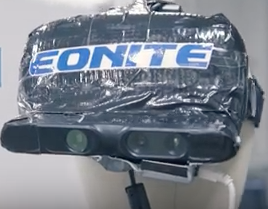VR is going through its own evolution and firms are looking to solve some interesting problems as we move closer to a suspended belief experience and enter the truly virtual world of computer generated reality. An issue is tracking natural movement in 3D space while inside a virtual world of suspended belief, that is mapped to the 3D world.
The effort surrounds a very natural human requirement, the need to move through free space, that is, headset tracking based on computer “vision.”
The problem is much like the challenges of the early computing era and then makers had to figure out how to move around using a mouse in the virtual 2D world of the PC. Only now, a virtual reality explorer literally “becomes the mouse”. That’s essential to get users to suspend belief.
Traditionally, motion tracking has been done using in room cameras and external trackers (Microsoft Kinect) that map the world flooding rooms in IR light and using external markers to help locate position. A new approach, dubbed ‘Inside out’ tracking, and used by Microsoft in its Hololens technology “is like the invention of the mouse,” according to Youssri Helmy, company founder who now heads Eonite, a Palo Alto, CA based software company working on the issue by placing the camera and depth sensor on the headset, with a solution they call the Vantage Head Tracker. (Eonite Claims Tracking Solution for AR/VR)
The company claims to have made one of the world’s most accurate, lowest latency, lowest power consuming inside-out positional head tracking software for HMDs. Specs include six DoF (degrees of freedom) without external hardware. Onboard, its software combined with a depth sensor and IMU motion data (inertial measurement unit) can deliver the same results as external tracking devices.
Camera based sensor mounted on HMD along with software provide inside out motion tracking Eonite said the headset tracker solution delivers sub-millimeter accuracy, motion-to-photon latency at less than 15 ms. This along with low power consumption (using a tablet-class GPU) makes the technology a good candidate for VR HMD’s according to Helmy. The system “democratizes” head tracking, by making VR motion available in any room. Inside-out positional head tracking proposed by Eonite opens this free form motion up to most HMD’s available on the market today.
For all their flaws, existing high-end VR systems are great at creating small worlds you can walk around naturally. But self-tracking headsets haven’t yet reached that point. Unfortunately, making a VR headset that works on its own in an ordinary room is tough. It’s one thing for an external camera to find an LED embedded in the Oculus Rift, or for sensors on a headset to pick up on clear external markers.
HTC Vive uses Inside-out tracking too, sort of–as the technology requires some degree of set-up, users must place two light towers (laser light based) in the room, which means the room has to be set up.
CES 2017 – Plenty of Evidence
There was plenty of evidence of alternative inside out tracking devices at CES, and the companies included some heavy hitters in hardware that are moving into VR in a big way. Intel’s Project Alloy prototype (based on RealSense technology) shown at their press conference, was offering what that company terms as merged reality, Oculus and Microsoft (both absent from the show) have Rift and HoloLens technology, respectively. Microsoft did publish a spec that includes its inside-out tracking and listed hardware partners (along with non-functional prototype devices) including Dell, Lenovo, HP and Acer, and others.
Make no mistake, like the first PCs move to GUI interface, this transition is not trivial, and results may change everything in the VR space. Inside out tracking uses both hardware and software to look at the world and calculate position based on no particular point of reference from sensors delivering both acceleration and depth. Like the move from command base (DOS) systems to GUI mouse-based PCs, generations before, perhaps this move will open up VR to the virtual world for the rest of us. – Steve Sechrist

